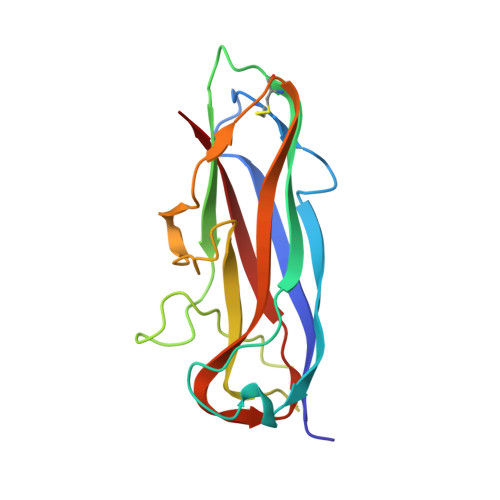Donor strand sequence, rather than donor strand orientation, determines the stability and non-equilibrium folding of the type 1 pilus subunit FimA.
Zyla, D., Echeverria, B., Glockshuber, R.(2020) J Biological Chem 295: 12437-12448
- PubMed: 32651228
- DOI: https://doi.org/10.1074/jbc.RA120.014324
- Primary Citation of Related Structures:
6R74, 6R7E, 6S09 - PubMed Abstract:
FimA is the main structural subunit of adhesive type 1 pili from uropathogenic Escherichia coli strains. Up to 3000 copies of FimA assemble to the helical pilus rod through a mechanism termed donor strand complementation, in which the incomplete immunoglobulin-like fold of each FimA subunit is complemented by the N-terminal extension (Nte) of the next subunit. The Nte of FimA, which exhibits a pseudo-palindromic sequence, is inserted in an antiparallel orientation relative to the last β-strand of the preceding subunit in the pilus. The resulting subunit-subunit interactions are extraordinarily stable against dissociation and unfolding. Alternatively, FimA can fold to a self-complemented monomer with anti-apoptotic activity, in which the Nte inserts intramolecularly into the FimA core in the opposite, parallel orientation. The FimA monomers, however, show dramatically lower thermodynamic stability compared with FimA subunits in the assembled pilus. Using self-complemented FimA variants with reversed, pseudo-palindromic extensions, we demonstrate that the high stability of FimA polymers is primarily caused by the specific interactions between the side chains of the Nte residues and the FimA core and not by the antiparallel orientation of the donor strand alone. In addition, we demonstrate that nonequilibrium two-state folding, a hallmark of FimA with the Nte inserted in the pilus rod-like, antiparallel orientation, only depends on the identity of the inserted Nte side chains and not on Nte orientation.
- Institute of Molecular Biology and Biophysics, ETH Zurich, Zurich, Switzerland.
Organizational Affiliation:

















